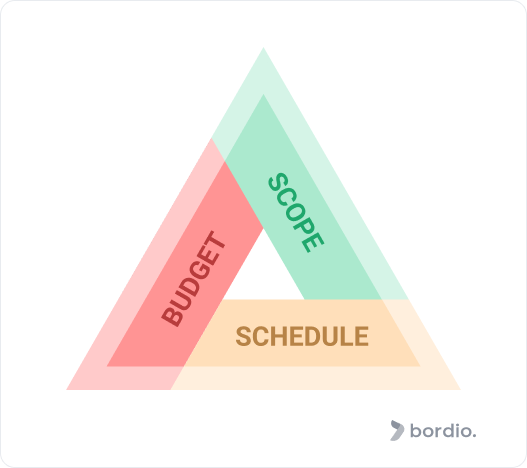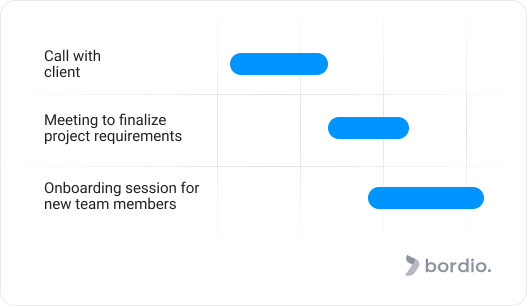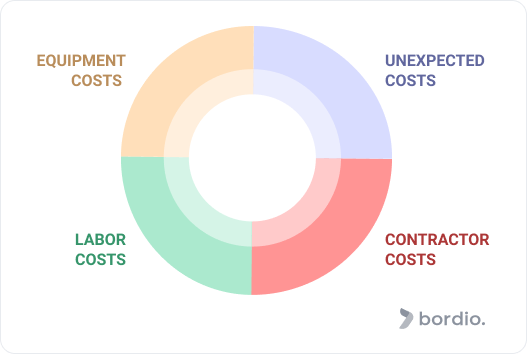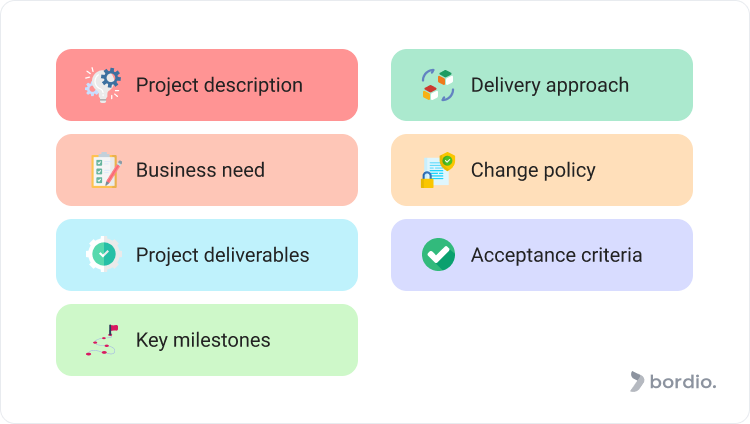In our blog, we will be sharing a series of articles about project management to help you deliver the best results, stay within the budget and timeframes, and not go crazy while doing it! So, if you are looking for insights and tips about executing a project well, then follow along!
Today, we will start from the beginning and look into the project baseline concept: what it is, how it works, and how you can create one.
What does the project baseline mean?
A project baseline is the starting and the reference point for your project plan.
Once it’s established, project managers use it to measure the progress and overall performance against the project’s timeline. It shows all project-related information: whether you are on track, if you are staying within the budget, if there are good or bad tendencies.
There are three main elements to the baseline. It’s the project schedule, cost, and scope.
The scope covers a detailed description of the business need for a project, its goals, key milestones and deliverables.
The schedule outlines the timeline to guide and monitor the success of the process.
The cost document provides a full budget and spending plan for the project.The baseline has to be understood and supported by all stakeholders. And an unclear baseline can result in project failure or conflicts.
The project baseline is sometimes referred to as the performance measurement baseline. It is practically the same thing, but minor variations are possible because there are multiple ways to build a project management process. So, if you hear the term “performance measurement baseline”, it is safe to assume that it’s the project baseline.
What constitutes a project baseline?
Creating a project baseline is not as hard as many people think. However, it does take some time, and it’s important that you pay attention to and think through every aspect of it. Otherwise, it makes no sense to work on it at all.
There are 3 major elements a project manager needs to figure out: a project schedule in schedule online maker, project cost, and project scope.
There is no particular order in which you should be working on the elements. And it might make sense to design them simultaneously as they are very interdependent.
Scope baseline
Project scope is an important project document that consolidates all project’s expectations and requirements as well as his tasks in the daily work tracker. It contains the following information:
What is the business need?
What business need does the project address, and what business issue does it solve? There has to be a clear reason for the project to exist. Doing something because it sounds fun or because we assume our clients want/need it is not good enough. Scope makes sure only projects with a valid reason to launch are approved. It might sound harsh, but a bunch of random projects that don’t have a purpose can ruin an otherwise healthy business. Resources are not limitless, so we need to be diligent.
What is expected at the end of the project?
What is the desired outcome? The second biggest mistake (after launching a project to solve a problem that doesn’t exist) is not having a clear goal in mind. Your end goal cannot be vague, like “make your clients happier” or “solve world hunger”. It needs to be a bit more detailed than that – write out the details in the free schedule planner. If you’d like to learn more about goal setting, check out our critical time management skills article.
It’s important to talk through and put in writing the acceptance criteria. All stakeholders have to be on the same page and evaluate the end result based on the same criteria.
Tip: Have acceptance criteria and other critical project data in writing somewhere everyone can see it. Bordio’s to-do list app is a perfect place to store important project information that you will need to refer to later. It is also the best for team tools for projects.
Key milestones, major deliverables, and the delivery approach
What will you show when the project is finished? It’s good to break the major deliverables into smaller ones. That way, everyone on the team, along with stakeholders, can understand the project life cycle and the route to accomplishing everything.
A popular project management tool that you can use here is a work breakdown structure or WBS. A WBS visualizes all the work that needs to be done and helps the during next steps when we work with cost management and baseline schedule. You can do it in a simple task organizer.
The project scope should not change unless there is a force majeure. Any additional unplanned work puts your project’s success at risk and has to be considered carefully.
Project milestones will be a great way to keep track of your progress without the pressure. Because milestones are not directly tied to KPIs and targets, achieving them is less anxiety-inducing and can help the project team get closer and celebrate the little wins.
Cost baseline
Cost management is not an exciting thing to do. But it has to be done thoroughly and triple-checked before approval. The last thing you want to do is have constant cost overruns and keep coming to the investors asking for a budget extension.
When planning the project cost baseline, calculate these two major points:
- The number of resources that each task will consume.
- The total cost of each task.
Do the research and talk to your colleagues to find out the project requirements in terms of resources. Get estimations from your local or favorite suppliers to calculate the actual cost of resources. It might make sense to add 10-20% to the total that you end up with, so if something happens and prices change, you still stay within the budget and avoid the cost overrun. See how many people will be involved and get their average hourly rates.
You should be able to tell the cost of the project at any intermediate point, so make sure you calculate and foresee every cost type that will occur.
Schedule baseline
Once you have the scope and cost ready, you can plan out the project schedule in time manager app.
- Create a task list. It helps to get input from your team to make sure you don’t miss anything.
- Calculate how long each task will take to complete and write it down.
- Assign a team member to each task and make sure it’s clear who needs to review and approve the task once completed.
- Schedule delays. They will happen, trust us. And if not – great! Now you have more wiggle room for tricky and more demanding parts of the project. The important thing is that you can provide for this and specify it in your free weekly schedule maker.
- Use the critical path method to have a visual representation of your project timeline.
You can use the schedule baseline to track and measure progress. It will show how much is supposed to be done by a certain date versus how much is actually done.
By the way, Bordio’s free daily planner has convenient time blocks that you can assign to each task to reflect the projected workload in the system. For example, if you have a report that takes 6 hours to make, create a task in the system and assign three 2-hour time blocks to it. It is very easy to use this system in Bordio’s task maker as well.
Team members can use those time blocks to block time in their weekly planner and guarantee that they have time to work on it. The task will only be completed after all the time blocks are completed. Project members can review their week’s workload and monitor how well they’re doing, making sure the project schedule is not disrupted.
Prepare for the change
Pro tip: plan for change.
Hardly any project is launched with a baseline that remains completely unchanged until the end. No matter how assured you are that your project will be an exception, plan for changes anyways. Consider it a part of the risk management strategy.
Examples of what can go wrong: someone gets sick, suppliers let you down by having no stock or changing prices last minute, the client goes 180 on their vision of the product, a global pandemic hits the world.
Tip: Read the top-10 project management challenges to be prepared for potential risks.
Every project manager needs to have a process outlined for when the change has happened. These questions will help you:
- What adjustments have to be made as a result of change?
- What are the new costs associated with change?
- Who needs to be notified of the change?
Of course, you can ignore this step and save yourself some time. However, when we plan for things in advance, it saves us much more time, stress, and energy when the events happen. The less prepared you are, the bigger setback you will experience. But pre-conceived plans and control through tools to manage remote employees.
Make sure you have a defined process for changes and don’t allow them too often. Ideally, you should avoid making changes unless it’s unavoidable.
There’s nothing wrong with change as such, but it tends to ruin the project performance without adding that much value to the end-product.
Is the project baseline important?
Project baseline plays an integral role in the success of the execution. It allows to:
- Efficiently oversee and manage changes in your schedule, cost, or scope.
- See interdependencies: how one thing affects everything else.
- Spot problems early. Before it’s too late and there is no cost-effective or easy way out.
Although the baseline has become a standard component of the project management by now, some teams still choose to ignore it, thinking they’ll be fine and that it’s just a waste of precious time.
If you feel the same, – we have to warn you. Not having a baseline in place can create multiple issues.
Luckily for us, projects exist for many years already. So if you’d like to learn what else is important for successful project management, have a look at the best project management books written by professionals in the field.
Potential problems if project baseline is not created
Here are some of the most common issues that project managers run into as a result of having no baseline.
Delays in stages and overall delivery
When there is no planned project schedule, things slip, and deadlines are missed. It’s hard to focus, prioritize tasks, and execute. Some tasks in general are better delegated to those who will be more professional, for example, if your team has very many tasks, it is worth using saas marketing agencies to have an agency do some of the marketing tasks. No amount of self-discipline and focus can compensate for lack of structure.
Inadequate monitoring
Monitoring a project’s progress is a nightmare when we don’t know the expected project deliverables or project objectives. Imagine walking to your developers and trying to review their work without the project plan? Needless to say, this will not be productive.
Insufficient resources
The beauty of the baseline is that it allocates and reserves the resources for every need. Without the assigned resources to each job, anyone can wipe out the financial or labor resources leaving the project budget empty. It is a great risk that jeopardizes the entire process.
Poor project management
It’s like building a house from scratch without an architectural plan or a foreman. Nobody knows where to start, how much time it will take, what the end-cost will be, or how many people should be involved. Sounds crazy, right? And it’s the same with any project you work on.
We’ve already talked about why project management is important, and skipping the baseline planning is a recipe for a disaster.
Quality management issues
How do you say what is good and what is bad quality? In life, we have a selection of criteria that we base our opinions on. A work project is no different. If you are a project manager, it’s really hard to work with your team without clear standards. In turn, for the team members, having no objective points to look at creates confusion and potential for error and might even lead to burnout.
A project baseline with clear instructions and expectations leaves no room for interpretation. Everyone knows what’s expected of them, and everyone delivers. Transparency and clarity are very important in work environments in general, and they should not be neglected in project management.
Creating a baseline brings many benefits
Let’s look at the top three benefits of having a plan for project’s progress, budget, and schedule.
More accurate project estimations
Project schedule and project budget go out of control instantly if you let them. And when you don’t control costs or timing, they control you.
Hardly anyone wants to have their project cost double and the project life cycle go crazy. When that happens, plans get frozen or cancelled, and people are fired. A thought-through baseline will make sure the chances of that happening are minimal.
Assistance in measuring the project’s performance
As time goes and weeks pass, the project is supposed to have intermediary results. A good baseline outlines the project timeline, making it clear when and how the progress should be evaluated. It also helps to spot any issues early in the project life cycle. And not a week away from the supposed deadline.
Then, once the project is finished, project managers and other stakeholders will have a document with estimations that they can compare to the actual performance and the end result, and the actual cost of the project versus the budget.
It makes a massive difference to the overall attitude of the project team who will be executing and overseeing each step. It’s one thing to work on something when the lines are blurred. It is a whole different story to know that your results will be examined closely and have a set of guidelines to help you deliver.
Fewer risks caused by uncertainty and unpredicted events
Projects face so many challenges already that there is no good reason why you should add more to the list. By introducing a baseline, we mitigate our risks and reduce uncertainties associated with poor preparation. And that’s already a big contribution towards success!
Pro tip: project baseline removes or reduces some of the risks. To get a full picture of what might impact your project, do a comprehensive analysis with a risk assessment matrix.
Stakeholder meeting
Communication is key. The project team, as well as other stakeholders, have to be aware of the project plan and consent to it.
When you have the first drafts of the baseline, share them with your key stakeholders to get their input early on. You might get surprising insights, or they can point out the factors that you’ve missed.
Once everything is finalized, invite everyone to another meeting and talk about the final project baseline. Don’t worry about being repetitive or wasting someone’s time.
During the meeting, communicate your change and ‘what if’ policy to the stakeholders, so you don’t receive random change requests in the middle of project execution. And if you do, you can safely decline them as everyone was warned about the procedure before the project started. Talk about the importance of keeping up with the project schedule and budget.
It might be difficult to say No to a change request if it comes from your client. In that case, they have to be fully aware of the consequences of last-minute changes. Once you share how many weeks of delays in the project schedule and extra dollars the change will result in, a lot of the change requests tend to go away.
After the baseline was reviewed and confirmed by all parties, send a follow-up email to everyone with a copy of the approved plan.
Pro tip: create a communication plan to outline and structure all project-related communication, its frequency and format. That way you will guarantee that stakeholders will be up to date and in the know about all the important stuff.
Final thoughts on baselining a project
Project baseline is an essential project management component that holds your project together. It keeps you on track, clients happy, and the team motivated. It helps compare the actual events with what is planned and see just how much the plan deviates from reality.
If you invest time in the planning process, work out a proper baseline, log everything in the digital calendar planner for the team to see, and you will survive all bumps on the road and deliver a quality result.











